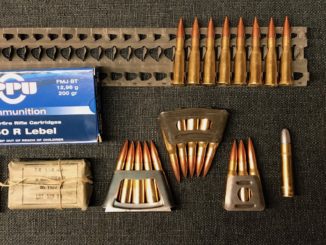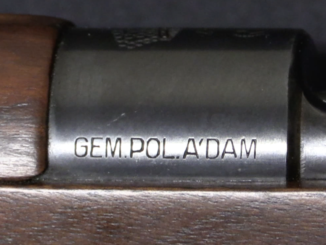The pinfire system was an early cartridge type which saw widespread use in Europe, but was not widely adopted in the United States. First invented by a French designer named Pauly, it was made commercially feasible by Casimir Lefaucheaux. It was Casimir’s son Eugene, however, who took the pinfire cartridge to its full potential, garnering a French military contract in the 1850s and building Lefaucheaux into one of the largest French/Belgian non-government arms manufacturers in the mid 1800s.
Todays we are looking at an assortment of pinfire revolvers, to get some basic idea for the sort of variety that was made over the decades. Small to large, plain to fancy, and with all manner of quirky details (like folding bayonets and Lefacheaux’s triple-action fire control system).




A couple of comments.
1. Caliber; For some reason, a lot of pinfire cartridges are gauged by the case diameter, rather than the diameter of the bore or bullet. For instance, a “12mm” round might indeed have a 12mm diameter cartridge case, but have a 9.5mm diameter bullet and be meant for a revolver with a 9.5mm diameter barrel. To be sure, you pretty much have to mike the bore and everything else.
2. Double-action vs. single-action; Actually, quite a lot of pinfire revolvers were single-action. The Lefaucheux Modele 1858, as issued to the French Navy, was a straight single-action.
In 1870, the French Navy adopted a new centerfire revolver, the Modele 1870. It was double-action, solid-frame, had a rod ejector and a loading gate, and was generally fully nickel-plated to protect it from salt air corrosion.
At the same time, most Lefaucheux M1858s in service were refurbished and modernized. They were converted from pinfire to centerfire, and from single-action to double-action. They also got a housing for their ejector rods, to prevent them from being bent; the exposed rods on such revolvers were rather vulnerable to this.
Known as the Modele 1858 Transformee’ 1870N, these Lefaucheuxs can generally be spotted by their bobbed hammer spurs (still there, but shorter and more rounded), and the lack of a “pin slot” in each chamber of the cylinder, plus the trigger’s more forward position in the trigger guard.
Unmodified naval-issue M1858s are actually rather rare.
cheers
eon
“1. Caliber”
Municion has article describing pin-fire cartridge aswell dimensions of them (scroll down to links to dimensions):
http://www.municion.org/lefaucheux/lefaucheux.htm
As you can see pin-fire cartridge can be found in various sizes: from tiny 2mm to giants like 4 gauge
Thanks, Eon!
The Modele 1858NT was indeed converted to centerfire, but it still had the pin slots. The ejector rod housing was added already in a 1867 modification called 1858N. The actual caliber of both the 12mm pinfire and 12mm centerfire naval cartridges was 10.7mm. There were many different “12mm” pinfire cartridges, which were all not compatible with the French Navy cartridge.
The Navy 12mm cartridge (both pin- and centerfire) was apparently more powerful than than the original, quite weak 11mm 1873 of the French Army. I have no information how it related to the later, significantly more powerful (but still fairly weak) 1873-90 loading of the 11mm.
Sources with pretty pictures:
http://www.revolver1873.fr/1873-marine.php
http://www.pistol3d.com/revolver_m1858_marine/m1858_marine.html
The second site has excellent images of early French revolvers in general, including pinfire ones, and some information in English as well.
11mm Mle 73 could be loaded with 0.6 grams of black powder dust or low pressure smokeless for better performances. (avoid this trick in a Le Faucheux)
Some hand-loaders tried to put 1 gram of black powder made for pistol, but their Chamelot-Delvigne was no more accurate with such amount.
I don’t think there was ever an official military smokeless loading for the 11mm Mle 73. There is an Internet page which suggests Vectan (SNPE) A1 powder up to 0.27 grams for reloading, actual powder weight depending on the case used:
http://www.tecmagazin.fr/blog_tir/2011/04/06/rechargement-et-essai-du-11mm73/
The historical 1873/90 loading was 0.8 grams of black powder with a 10.6 grams bullet, which achieved a muzzle velocity of 190 m/s.
“The pinfire system was an early cartridge type which saw widespread use in Europe, but was not widely adopted in the United States. First invented by a French designer named Pauly, it was made commercially feasible by Casimir Lefacheaux.”
Pauly invented self-containing cartridge but it was NOT pinfire, see cross-cut here: https://en.wikipedia.org/wiki/Needle_gun#Pauly_needle_gun
Great overview Ian. A comparison to Colt, Smith and Wesson, etc. on the mid 1860’s production numbers would have been a good addition.
This page:
http://www.pistol3d.com/revolver_lefaucheux_m1854/lefaucheux_m1854.html
Says about 115,000 for the Lefaucheux Mle 1854 alone. Unfortunately it does not give production numbers for other models, except about 6000 for the Mle 1858 Navy revolver; an understandably low number for a naval handgun.
Were the pin-fire LeMat revolvers considered impractical for civilian usage due to overall weight once drawn from the holster? Were they safer to operate than most rim-fire revolvers or more dangerous due to the protruding cartridge pins?
Pinfire LeMats were actually quite common on the civilian market in Europe for a short time. Most had the center (shotgun) barrel as a percussion muzzleloader,like the earlier cap-and-ball LeMats.
Pinfire LeMats were made from about 1865 to 1870, when they were superseded by centerfires. I don’t recall ever seeing a rimfire version. (Which of course proves exactly nothing.)
cheers
eon
The thing that I find most interesting is that the Mle 1854 Lefaucheux predated Rollin White’s patent with a bored through cylinder that actually worked as opposed to White’s patent design which was a back fire waiting to happen. The very fact that Whitney et al lost their patent infringement suit from White and S&W is a perfect example of how our legal system can be the victim of unscrupulous jurists who do not recuse themselves from cases where they have a conflict of interest due to personal antipathy against one of the litigant’s attorneys. Had Remington, Whitney or Colt manufactured even one model of a pinfire revolver using Lefaucheux’s patent which was prior to White’s, they would have had a much better chance to beat White in the lower courts
More to the point, the French patent should have been both recorded and honored in the U.S. due to the patent reciprocity agreement that the U.S. and French governments had dating back to just after the American War of Independence. It stayed in force through the Napoleonic period and the Second Empire, and AFAIK is still in force today.
A standard patent search by the U.S. Patent Office should have turned up the LeFaucheux patent in their own files.
The fact that it either didn’t, or that such a search was not made, leads me to suspect some hanky-panky was involved.
I might add that there’s a very good chance that White was perfectly aware of the LeFaucheux patent. He had a bad habit of “appropriating” existing foreign patents, filing slightly-altered versions in his own name, and then trying to sue the actual originators for infringement. Fundamentally, he was a confidence trickster more than anything else.
He didn’t stumble into a gold mine with his deal with Horace Smith and Daniel Wesson, either. Under the agreement, he got a royalty on each metallic-cartridge revolver S&W made, provided that he took anyone who infringed the patent to court on his own nickel, not S&W’s. So in the end, most of his not-inconsiderable royalties went for legal fees.
IMHO, it’s no more than he deserved.
cheers
eon
Sadly, patent trolls existed, exist and will exist, for more modern example see:
http://strangeinventions.com/2013/03/13/method-of-exercising-a-cat/
Found a pocket pinfire revolver complete with vintage carrying case at a antique show here in Nagoya. It looked to be about 8 or 9mm ,of Belgium manufacture and in very very good working condition. I was very surprised to see it.
If you are interested in shooting it, but has no reasonable price source of cartridge see: http://hlebooks.com/pinfire/pin00.htm
Daweo thanks for the link,definitely looks like a diy project to fire the pistol. I didn’t purchase the pinfire for two reasons, price out of my means and legality. The Japanese government frowns upon civilian ownership of pistols,their almost impossible to acquire a license for. Only sporting firearms are allowed, even air rifles require a license with a purpose for ownership. Edo era matchlocks can be possessed with an antique weapons license. Just not shure where the pinfire would fit in. It must have came into Japan in the Meji era. I saw a flyer from the Nagoya police dpt. in the subway station advising people who find old firearms in old houses to turn them in. They had photos of old pistols turned in, a artillery Luger with tangent sight( so sad) a early war type 94( wish I had for my collection) and a rough nickel plated Hopkins and Allen top break revolver. It definitely ain’t the U.S. thanks again
Gasser heavily borrowed from pinfire revolvers in making of 1970 model – both double action, which is identical, an automatic safety* feature (borrowed from Francotte), construction of frame and barrel etc. 2nd from a left on the video is actually almost identical in construction to Gasser 1870, except lacking automated safety.
*Automated safety engaged two pins into mechanism (blocking hammer) when hammer was placed on half-cock. Those could be disengaged either by thumbing hammer manually, or by pulling a trigger in DA mode. This was much safer than half-cock notch that could actually break off if revolver fell on a hammer. I tried how safe were those on wracked Gasser 1870, even hitting a hammer with (rubber) mallet quite hard could not induce hammer to fall when on half-cock.
So, Ian, maybe special about Gasser revolvers next? “Peacemaker of Balkans” certainly deserves it. 🙂
It is pleasing to see a presenter who knows his subject, and who is not simply reading from notes. You are a good speaker, and your spoken english is to a high standard. These things made the presentation try watchable. Thank you. Tony, UK.
Please read ‘very’ in place of ‘try’ – a typo.